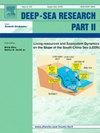Spatial and temporal variations in net primary production and long-term trends between 2003 and 2022 in the Indian Ocean: A synthesis using different models
IF 3
3区 地球科学
Q2 OCEANOGRAPHY
Deep-sea Research Part Ii-topical Studies in Oceanography
Pub Date : 2025-03-05
DOI:10.1016/j.dsr2.2025.105468
引用次数: 0
Abstract
The measurements of net particulate primary production (NPP) with reference to space and time are limited in the Indian Ocean. Therefore, models are the only source of understanding spatial, temporal, and long-term variations. Different models have been developed to use remote sensing data to estimate NPP in the Indian Ocean. However, the accuracy of these models has not been evaluated. Here, we used the measured NPP data collected between 2003 and 2022 in the Indian Ocean to compare with different models such as Vertically Generalized Production (VGPM), Carbon-based Production (CbPM), Eppley-VGPM, and Carbon, Absorption, Fluorescence, Euphotic resolved (CAFE) models. This comparison suggested that CbPM simulated NPP with 10% underestimation compared to measured NPP in the Arabian Sea and South Indian Ocean (SIO), whereas VGPM simulated NPP well in the Bay of Bengal (BoB). The Eppley-VGPM over (under) estimated measured NPP by 20–30% in the SIO (Arabian Sea), while the CAFE model underestimated NPP in the BoB by 25%. No single model simulated the NPP well in the entire Indian Ocean compared to the measurements. All models reproduced seasonality in the Arabian Sea and SIO, but they failed in the case of the BoB. Compared to the measured NPP, the VGPM and CAFE models underestimated NPP, whereas the CbPM and Eppley-VGPM models overestimated it. Variable rates of changes in NPP in the past two decades were simulated in the Indian Ocean by different models. The long-term trends simulated by CbPM suggest decreasing trends in NPP south of 12°N and no trends north of 12°N in the Arabian Sea and increasing trends in NPP south of 20°S and decreasing trends north of 20°S in the SIO. The VGPM model indicated no significant trends in the BoB. The trends by the other models are variable and contrast in some regions. Therefore, the selection of an appropriate model to study long-term trends in NPP in the Indian Ocean is crucial.
2003 - 2022年印度洋净初级产量的时空变化和长期趋势:使用不同模式的综合
印度洋的净颗粒物初级生产量(NPP)在空间和时间上的测量是有限的。因此,模型是理解空间、时间和长期变化的唯一来源。已经开发了不同的模型来利用遥感数据估计印度洋的NPP。然而,这些模型的准确性尚未得到评估。在这里,我们使用了2003年至2022年间收集的印度洋NPP测量数据,并与不同的模式进行了比较,如垂直广义生产(VGPM)、碳基生产(CbPM)、Eppley-VGPM和碳、吸收、荧光、光分辨(CAFE)模式。这一比较表明,与阿拉伯海和南印度洋(SIO)的实测NPP相比,CbPM模拟的NPP低估了10%,而VGPM在孟加拉湾(BoB)模拟的NPP很好。Eppley-VGPM高估(低估)了SIO(阿拉伯海)测量的NPP,而CAFE模式低估了BoB的NPP,低估了25%。与测量结果相比,没有一个模型能很好地模拟整个印度洋的NPP。所有模式都再现了阿拉伯海和SIO的季节性,但它们在BoB的情况下失败了。与实测的NPP相比,VGPM和CAFE模型低估了NPP,而CbPM和Eppley-VGPM模型高估了NPP。用不同的模式模拟了过去20年印度洋NPP的变化速率。CbPM模拟的长期趋势表明,阿拉伯海12°N以南的NPP呈减少趋势,而12°N以北的NPP无减少趋势,SIO 20°S以南的NPP呈增加趋势,20°S以北的NPP呈减少趋势。VGPM模型显示BoB没有明显的变化趋势。其他模式的趋势在某些地区是可变的和相反的。因此,选择合适的模式来研究印度洋NPP的长期趋势是至关重要的。
本文章由计算机程序翻译,如有差异,请以英文原文为准。
求助全文
约1分钟内获得全文
求助全文
来源期刊
CiteScore
6.40
自引率
16.70%
发文量
115
审稿时长
3 months
期刊介绍:
Deep-Sea Research Part II: Topical Studies in Oceanography publishes topical issues from the many international and interdisciplinary projects which are undertaken in oceanography. Besides these special issues from projects, the journal publishes collections of papers presented at conferences. The special issues regularly have electronic annexes of non-text material (numerical data, images, images, video, etc.) which are published with the special issues in ScienceDirect. Deep-Sea Research Part II was split off as a separate journal devoted to topical issues in 1993. Its companion journal Deep-Sea Research Part I: Oceanographic Research Papers, publishes the regular research papers in this area.

 求助内容:
求助内容: 应助结果提醒方式:
应助结果提醒方式:


